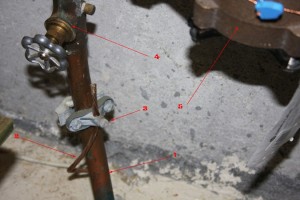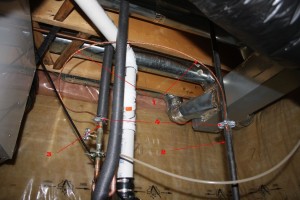Since 2010, the B149.1 Natural Gas and Propane Installation code requires propane and natural gas systems to be bonded. This article, which first appeared in the Mar/Apr 2013 edition of Propane Canada magazine, discusses how bonding of the gas system is achieved and includes key definitions related to bonding.
Since writing the article entitled “The Need for Bonding of Corrugated Stainless Steel Tubing (CSST) Systems”, which first appeared in the Jan/Feb 2013 edition of Propane Canada magazine, I’ve had several requests for additional information explaining how one actually goes about bonding propane and natural gas systems.
When the 2010 CSA B149.1 Natural Gas and Propane Installation Code was published and adopted by provincial regulation, the bonding of propane and natural gas piping systems became a requirement of the Code.
Key Definitions
The following terms and definitions are commonly used to describe technical requirements:
Bonded (Bonding)
Connected to establish electrical continuity and conductivity.
Bonding Jumper
A reliable conductor to ensure the required electrical conductivity between metal parts required to be electrically connected.
Grounded (Grounding)
Connected (connecting) to ground or to a conductive body that extends the ground connection.
Grounding Electrode Conductor
A conductor used to connect the system grounded conductor or the appliance to a grounding electrode or to a point on the grounding electrode system.
Grounding Electrode System
Electrodes can be a metal rod/pipe/plate driven into the ground; the metal frame of a building; buried metal or copper water line into the building; a ground ring of copper wire; or a concrete encased foundation electrode.
Clause 4.7.3 of the Code requires that all interior metal gas piping that may become energized must be made electrically continuous and bonded in accordance with the requirements of the local electrical code or, in the absence of such, the Canadian Electrical Code, Part 1.
The 2012 Canadian Electrical Code Clause 10-400 (4) has the same wording as clause 4.7.3 in the CSA – B 149.1. Clause 6.14.6 of the Code does not permit propane and natural gas piping or tubing to be used for an electrical ground. The clause states that an electric circuit cannot utilize piping or tubing in lieu of wiring, except for a low-voltage control circuit, ignition circuit, or electronic flame detection device circuit incorporated as part of an appliance.
The Canadian Electrical Code requires the house’s electrical system have a connection to earth to provide for its safe operation. When other systems are connected to the electrical system and its grounding, those systems are “bonded” to the electrical ground.
Bonding is provided primarily to prevent a possible electric shock hazard for persons coming into contact with the gas piping and other metal objects that are connected to the grounding system, but which may be energized at a different level of electrical potential.
Gas piping can become energized by an electrical fault in the branch circuit of a gas appliance connected to the piping system. Nearby lightning strikes can also result in an unbalanced voltage build-up and a resulting high electrical potential difference.
An electrical bond is an intentionally installed electrically conductive and continuous path from the gas piping to the grounding electrode system. The systems that are bonded to the electrical system will have roughly the same electrical potential, so that if energized, they will all be energized at the same rate and at the same speed. Thus, when the electrical system and the bonded systems are energized by an electrical fault or lightning, the possibility that the electrical energy will arc or jump from one system to the other is reduced because all those systems are at an equal electrical state.
A bonding wire from one metal component to another allows stray electricity to equalize through the wire so that one metal component will not have a greater voltage in it than another metal component, preventing arcing between the two metal components. However, if metal systems in the house are not bonded to the electrical ground, they will have a different electrical potential from other conductive systems in the house.
In the event those systems are energized by a high voltage event like lightning, then it is possible that the electricity being conducted and travelling on one metal system may come to a point where it is close to an adjacent metal system that offers a lower resistance or impedance path to ground.
It is possible that if the energy has enough voltage, it may jump over the air gap between the two adjacent metal systems, and use the second path to go to ground. When the energy jumps that air gap, it generates an electrical arc that has a high voltage.
Photo #1 provides an example of grounding the house’s electrical system. The copper underground water service that runs from the water main in the street to the house acts as the in-situ grounding electrode.

Photo #1 – 1) Underground water service line at entrance to house. 2) Bare grounding wire connecting electrical panel & water line. 3) Grounding clamp attached to water service line. 4) Water service shut-off valve. 5) Water meter.
Bonding is achieved by installing a wire of sufficient size from the bonded component to the electrical system ground. Equipotential bonding is achieved when all metallic systems in a structure are bonded to the electrical system ground.
Minimum bond wire should be a number 6 AWG copper wire. The bonding clamp must be attached such that metal to metal contact is achieved with the steel pipe component. Remove any paint or applied coating on the pipe surface beneath the clamp.
As discussed in my previous article on bonding of Corrugated Stainless Steel Tubing (CSST), the bonding clamps must be attached to the brass fitting, to a steel manifold or to a rigid pipe component attached to the CSST. The corrugated stainless steel portion of the tubing system must not be used as the bonding attachment.

Photo #2 – 1) Bare bonding wire. 2) Steel propane/natural gas piping. 3) Copper wire line to water heater. 4) Bonding clamps.
Photo #2 above, shows the bonding wire attached to the steel gas piping and the copper cold water line feeding the water heater. The bonding connection is by mechanical clamps. UL-467-approved bonding clamps can be used.
Under no circumstances is any underground natural gas utility service line or the underground supply line from a propane storage tank to be used as a grounding electrode because grounding electrodes are intended to carry large currents.
This can expose the piping to the possibility of sparking which can create a hazardous condition if the service piping is undergoing any type of maintenance.
